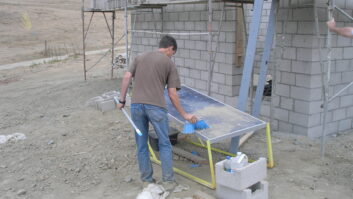Spring pollen and ragweed season were particularly rough this year, according to Harry Bingaman, engineering manager for Sunbury Broadcasting in Sunbury, Pa.
(click thumbnail)Fig. 1: Pollen covers an air intake screen.Harry says he’d never seen it so bad. Check out Figs. 1 and 2; the second image shows the accumulation of just two days. That’s not dryer lint!
Harry made window screen covers last year and placed them on the outside of the fresh air intake vents at his sites. The screens kept most of this gunk out of his transmitters. Pleated filters on the transmitters also work overtime in such conditions.
Although screen cleaning each spring is another recurring chore, they keep most of this stuff out of the building.
Harry also made brackets to support a standard furnace filter on the inside; it works as a secondary catch for finer material.
* * *
Bill Whitt works for KBLN(TV) in Grants Pass, Ore., a publicly supported TV operation with about 17 transmit locations.
He started his career as an electronics technician in the Navy, then moved to a variety of manufacturing jobs. Along the way, Bill discovered a neat source for tools and shares it with Workbench readers.
(click thumbnail)Fig. 2: Just two days of pollen left this layer, shown partially peeled away.He says www.nationalonlinetools.com will keep you busy for hours. They sell nearly every type of tool made, all at discount prices.
For example, you can buy a Raytek 0-500 degree digital thermometer gun — with a laser sight — for under $50. Or here’s something new: a Bayco 13W rechargeable cordless fluorescent trouble lamp. It runs about 100 minutes on a charge and costs only $35. Imagine, no more tangled cords as you poke around the inside of your transmitter or equipment rack.
Who doesn’t like to save money on tools?
* * *
Matt Monin is from Greenbrier, Ark. As a contract engineer, he comes across of lot of unusual things.
For instance he was called to a new client’s station and was working on an old FM5K1 when he noticed that a previous engineer had used rocks to keep a capacitor seated. See Fig. 3.
When a capacitor with a different diameter than the original was used as a replacement, someone thought to use a rock as a spacer.
(click thumbnail)Fig. 3: A rock holds the capacitor stable.Although the transmitter subsequently has been cleaned, the rock remains — and the capacitor, too.
* * *
In another life Joel O’Brien worked for Warner Cable in direct sales. Joel sends in a tip learned from the cable techs on how to run cable long distances in conduit (and it doesn’t involve a dog).
Joel starts with a spool of good fishing line. He then walks the line the length of conduit, unspooling it as he goes along.
The next step is to tie a small rag, maybe 1 by 3 inches or so, to the end of the line. Tie it tight!
It doesn’t matter if the conduit is buried or not. Stuff the rag tie into the conduit as much as you can. Then go to the other end of the conduit. Take your shop vacuum, put the hose right over the conduit and turn on the vac.
The rag tie should pull the fishing line through the conduit; then you can tightly tie the cable or wire you want to snake through and pull it the length of the conduit.
Joel says this worked for him when he needed to run 400 feet of RG-6 from the pole to his house. He thought this might be one of those things everyone knew. Maybe so, maybe not; with so many new engineers, tips like these are helpful to us all.
* * *
Cris Alexander of Crawford Broadcasting, a fellow contributor to Radio World, passes along some tips from Don Johnson, engineering and technical support engineer for Bext Inc.
Don works in the repair department and is responsible for repairs and shipments of equipment sent in to the company.
A common sight is heavy items that have been broken in shipping. Usually these products have been shipped via a local packaging store.
Even though the problems often are easy to fix — broken rack handles and bent BNC connectors — such damage causes a unit to be delayed in repair, because the shipping agent will want to see the damage before it is repaired.
To avoid the problem, stations need to be responsible for their own packaging. This includes triple-layer cardboard boxes rated for the weight of the item; solid packing foam at least 1-1/2 inches beyond the farthest corner of the item; no bubble wrap if the item is over 15 pounds; and no popcorn, ever.
If you cannot find the proper packing material, Don suggests you use spray cans of insulation foam, available at your local hardware store.
The procedure is straightforward: Spray about 2 inches in the bottom of the box, then place a layer of plastic sheet over the foam. Remember that the foam will continue to expand after you stop spraying.
As it starts to harden and stops expanding, place the unit in the box. Note that the unit should be inside a plastic bag, separate from the plastic liner in the box.
Now spray around the edges of the box a bit at a time. Place a plastic sheet over the item and spray in a foam cover. Again, remember that the foam will expand for quite a while after you stop so use less than you think you’ll need.
Don has heard a rule of thumb about shipping: After it’s packed, would you allow the box to fall 10 feet onto a concrete floor? If not, repack it.















